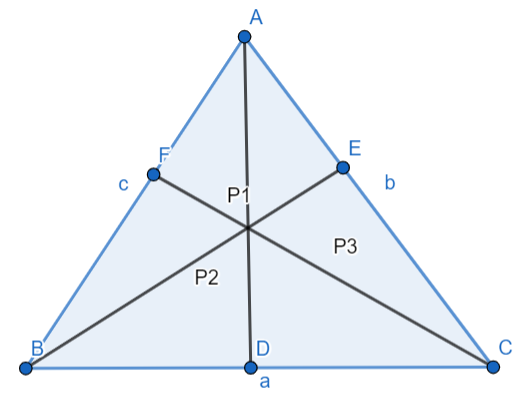
Answer
412.2k+ views
Hint: Find the area of triangle by taking three different sets of base and height. Then express ${{p}_{1}}$,${{p}_{2}}$ and ${{p}_{3}}$ in terms of area. After getting the values of ${{p}_{1}}$,${{p}_{2}}$ and ${{p}_{3}}$ multiply them and do the necessary simplification to get the required result.
Complete step by step answer:

Let us consider a triangle $\vartriangle ABC$ with sides a, b and c.
${{p}_{1}},{{p}_{2}},{{p}_{3}}$ are the perpendiculars drawn from the vertices A, B and C respectively.
We know the area of triangle $=\dfrac{1}{2}\times base\times height$
Again let us denote the area of triangle ABC as ‘A’.
Here the area can be expressed in three different ways as we have three different sets of base and height.
So, the area of triangle ABC
$\begin{align}
& A=\dfrac{1}{2}\times BC\times AD \\
& \Rightarrow A=\dfrac{1}{2}\times a\times {{p}_{1}} \\
\end{align}$
So, ${{p}_{1}}$ can be written as
$\Rightarrow {{p}_{1}}=\dfrac{2A}{a}$
Again,
$\begin{align}
& A=\dfrac{1}{2}\times AC\times BE \\
& \Rightarrow A=\dfrac{1}{2}\times b\times {{p}_{2}} \\
\end{align}$
So, ${{p}_{2}}$ can be written as
$\Rightarrow {{p}_{2}}=\dfrac{2A}{b}$
Again,
$\begin{align}
& A=\dfrac{1}{2}\times AC\times CF \\
& \Rightarrow A=\dfrac{1}{2}\times c\times {{p}_{3}} \\
\end{align}$
So, ${{p}_{3}}$ can be written as
$\Rightarrow {{p}_{3}}=\dfrac{2A}{c}$
Hence,
$\begin{align}
& {{p}_{1}}{{p}_{2}}{{p}_{3}}=\dfrac{2A}{a}\times \dfrac{2A}{b}\times \dfrac{2A}{c} \\
& \Rightarrow {{p}_{1}}{{p}_{2}}{{p}_{3}}=\dfrac{8{{A}^{3}}}{abc} \\
\end{align}$
Again as we know \[A=\dfrac{abc}{4R}\] (from sine rule of triangle) where ‘R’ is the radius of the circumcircle.
So, putting the value of ‘A’ in the above expression, we get
$\begin{align}
& \Rightarrow {{p}_{1}}{{p}_{2}}{{p}_{3}}=\dfrac{8{{\left( \dfrac{abc}{4R} \right)}^{3}}}{abc} \\
& \Rightarrow {{p}_{1}}{{p}_{2}}{{p}_{3}}=\dfrac{8{{a}^{3}}{{b}^{3}}{{c}^{3}}}{64{{R}^{3}}abc} \\
& \Rightarrow {{p}_{1}}{{p}_{2}}{{p}_{3}}=\dfrac{{{a}^{2}}{{b}^{2}}{{c}^{2}}}{8{{R}^{3}}} \\
\end{align}$
This is the required solution of the given question.
Note: For the above triangle $\vartriangle ABC$ with sides a, b, c and area ‘A’, the measure of circumradius ‘R’ is $R=\dfrac{abc}{4A}$.
Which can be written as
\[\Rightarrow A=\dfrac{abc}{4R}\]
This value of area is used in the above solution to get the result in a simplified form.
Complete step by step answer:

Let us consider a triangle $\vartriangle ABC$ with sides a, b and c.
${{p}_{1}},{{p}_{2}},{{p}_{3}}$ are the perpendiculars drawn from the vertices A, B and C respectively.
We know the area of triangle $=\dfrac{1}{2}\times base\times height$
Again let us denote the area of triangle ABC as ‘A’.
Here the area can be expressed in three different ways as we have three different sets of base and height.
So, the area of triangle ABC
$\begin{align}
& A=\dfrac{1}{2}\times BC\times AD \\
& \Rightarrow A=\dfrac{1}{2}\times a\times {{p}_{1}} \\
\end{align}$
So, ${{p}_{1}}$ can be written as
$\Rightarrow {{p}_{1}}=\dfrac{2A}{a}$
Again,
$\begin{align}
& A=\dfrac{1}{2}\times AC\times BE \\
& \Rightarrow A=\dfrac{1}{2}\times b\times {{p}_{2}} \\
\end{align}$
So, ${{p}_{2}}$ can be written as
$\Rightarrow {{p}_{2}}=\dfrac{2A}{b}$
Again,
$\begin{align}
& A=\dfrac{1}{2}\times AC\times CF \\
& \Rightarrow A=\dfrac{1}{2}\times c\times {{p}_{3}} \\
\end{align}$
So, ${{p}_{3}}$ can be written as
$\Rightarrow {{p}_{3}}=\dfrac{2A}{c}$
Hence,
$\begin{align}
& {{p}_{1}}{{p}_{2}}{{p}_{3}}=\dfrac{2A}{a}\times \dfrac{2A}{b}\times \dfrac{2A}{c} \\
& \Rightarrow {{p}_{1}}{{p}_{2}}{{p}_{3}}=\dfrac{8{{A}^{3}}}{abc} \\
\end{align}$
Again as we know \[A=\dfrac{abc}{4R}\] (from sine rule of triangle) where ‘R’ is the radius of the circumcircle.
So, putting the value of ‘A’ in the above expression, we get
$\begin{align}
& \Rightarrow {{p}_{1}}{{p}_{2}}{{p}_{3}}=\dfrac{8{{\left( \dfrac{abc}{4R} \right)}^{3}}}{abc} \\
& \Rightarrow {{p}_{1}}{{p}_{2}}{{p}_{3}}=\dfrac{8{{a}^{3}}{{b}^{3}}{{c}^{3}}}{64{{R}^{3}}abc} \\
& \Rightarrow {{p}_{1}}{{p}_{2}}{{p}_{3}}=\dfrac{{{a}^{2}}{{b}^{2}}{{c}^{2}}}{8{{R}^{3}}} \\
\end{align}$
This is the required solution of the given question.
Note: For the above triangle $\vartriangle ABC$ with sides a, b, c and area ‘A’, the measure of circumradius ‘R’ is $R=\dfrac{abc}{4A}$.
Which can be written as
\[\Rightarrow A=\dfrac{abc}{4R}\]
This value of area is used in the above solution to get the result in a simplified form.
Recently Updated Pages
How many sigma and pi bonds are present in HCequiv class 11 chemistry CBSE

Mark and label the given geoinformation on the outline class 11 social science CBSE

When people say No pun intended what does that mea class 8 english CBSE

Name the states which share their boundary with Indias class 9 social science CBSE

Give an account of the Northern Plains of India class 9 social science CBSE

Change the following sentences into negative and interrogative class 10 english CBSE

Trending doubts
Fill the blanks with the suitable prepositions 1 The class 9 english CBSE

The Equation xxx + 2 is Satisfied when x is Equal to Class 10 Maths

In Indian rupees 1 trillion is equal to how many c class 8 maths CBSE

Which are the Top 10 Largest Countries of the World?

How do you graph the function fx 4x class 9 maths CBSE

Give 10 examples for herbs , shrubs , climbers , creepers

Difference Between Plant Cell and Animal Cell

Difference between Prokaryotic cell and Eukaryotic class 11 biology CBSE

Why is there a time difference of about 5 hours between class 10 social science CBSE



